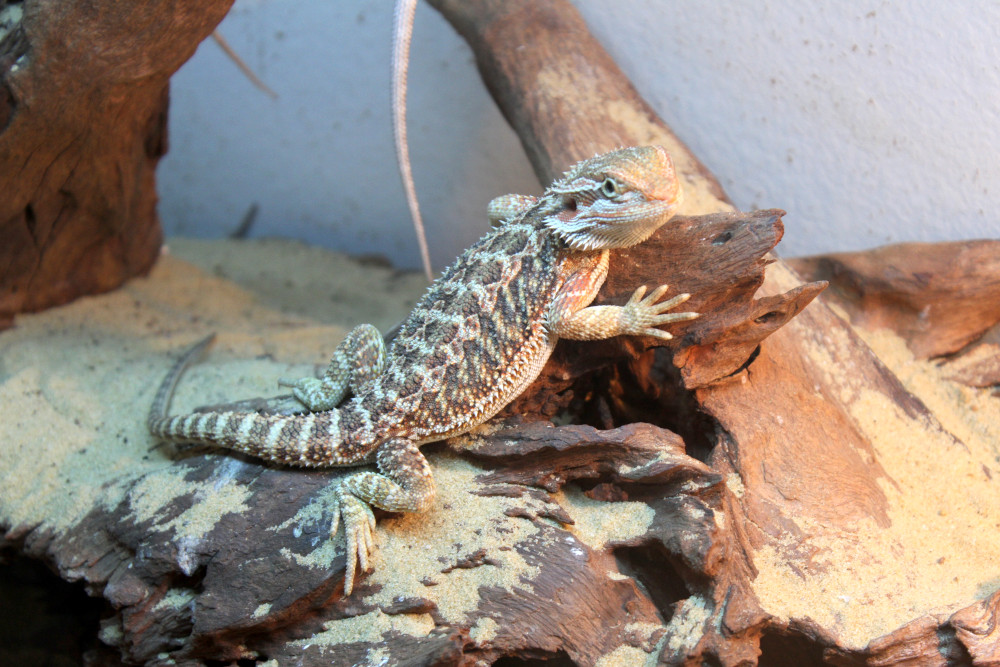Where should I keep my reptile?

Where you put your reptile’s enclosure depends on a few different things, including:
- Temperature
- Sunlight
- Disturbances
- How much space your reptile needs
In this article, we’ll go through these factors so that you can choose the best location for your reptile. We will focus on indoor enclosures, but many of the considerations also apply for outdoor cages and pens.
Temperature
Many people think that, by placing their reptile’s enclosure by a window, they are providing warmth, UVB radiation, and environmental enrichment. Unfortunately, this is not correct, for a few reasons:
- Direct sunlight coming in through the window will overheat and possibly kill your reptile.
- Alternatively, if the window lets out a lot of heat, it could make your reptile too cold;
- The glass will filter out any UVB radiation (see below for why this is important).
Another consideration is whether to place the enclosure on the floor, or up on a bench. In some rooms of your house the floor will be much cooler than other heights – especially on the ground level of your house. This is because heat naturally rises, leaving cooler air at the floor level. Placing the enclosure on a bench may be a better option unless the floor is well insulated and warm.
Make sure there aren’t any drafts around the area you are thinking of putting the enclosure, as these can cause your reptile’s enclosure to be too cold.
Sunlight
Sunlight contains both white light and ultraviolet radiation. Both are important to your reptile’s health, and it is important that they receive the correct amounts of each.
Remember, don’t rely on sunlight coming through a window, as unfortunately the essential UVB light is filtered out almost completely by glass and plastic.
Disturbances
A lot of reptiles get very upset by heavy vibrations, and your floor is basically a conductor for vibrations. The vibrations can be from everyday activities such as people walking, vacuuming, or traffic. Raising an enclosure on a shelf, table, or stand means it receives less intense vibrations because the stand has a dampening effect.
Captive reptiles tolerate people and our associated disturbances to a certain extent, but still need their peace and quiet to be physically and mentally healthy. Too much activity around their enclosure will result in them suffering from stress, poorer welfare, and either becoming aggressive or anorexic, depending on the species.
How much space does your reptile need?
You will need to plan ahead to make sure you have enough room in both the enclosure and the room if the animal continues to grow. What seemed to be an ideal size last year may be too small next year, as your reptile will need a bigger enclosure the bigger they get.
Summary
Place your reptile’s enclosure in a part of the room where you are certain direct sunlight cannot fall on it, and where the temperature is as stable as possible.
If you put a reptile enclosure in a spot that gets too hot or too cold, the strain on your heating appliance will increase, resulting in:
- The enclosure getting too hot or too cold, making your reptile sick.
- The heating appliance overheating, if the spot is too cold. At best you might blow an expensive heating lamp; at worst, you may start a fire. (Thermostats do help keep things safer, but not if the thermostat probe is placed too far away from the heat source. This is an important point to remember!).
- The need to invest in air conditioning if the enclosure gets too hot.
- Your electricity bill going up and up!
When choosing which room to put your reptile’s enclosure in, always pick the quietest room that gets used the least.
Make sure you allow plenty of room for your reptile’s growth.
Bibliography
Baines F (2017) Lighting. In: Doneley B, Monks D, Johnson R, Carmel B (eds) Reptile Medicine and Surgery in Clinical Practice. Wiley-Blackwell, pp 75–90
O’Malley B (2017) Anatomy and Physiology of Reptiles. In: Doneley B, Monks D, Johnson R, Carmel B (eds) Reptile Medicine and Surgery in Clinical Practice. Wiley-Blackwell, pp 15–32
Carmel B, Johnson R (2014) A guide to health and disease in reptiles & amphibians. Reptile Publications, Burleigh
RSPCA Australia believes that captive-bred wild animals should not be kept in a home environment or for companion purposes unless the species has been clearly identified as being suitable for this purpose. It is important that animals living in a home environment can live a good life. This means providing for their physical health and ensuring opportunities to fully express their individual interests and experience good welfare. Inadequate care and husbandry are reported to contribute to common and serious welfare compromises in many captive wild animals living in home environments. For more information see our policy.
The reality is, however, that captive-bred wild animals are kept in home environments despite sometimes not meeting these criteria (e.g., some reptile and bird species). Because of this, the RSPCA has produced these articles on the care and welfare of a variety of commonly kept captive-bred wild animals. The aim is to help people better understand their animals as individuals and provide them with care that keeps them healthy and provides opportunities for positive mental experiences as much as possible in captivity.
Wild animals must not be taken from the wild to be kept as companion animals (pets).
Was this article helpful?
This work is licensed under a Creative Commons Attribution-NonCommercial-NoDerivatives 4.0 International License.



